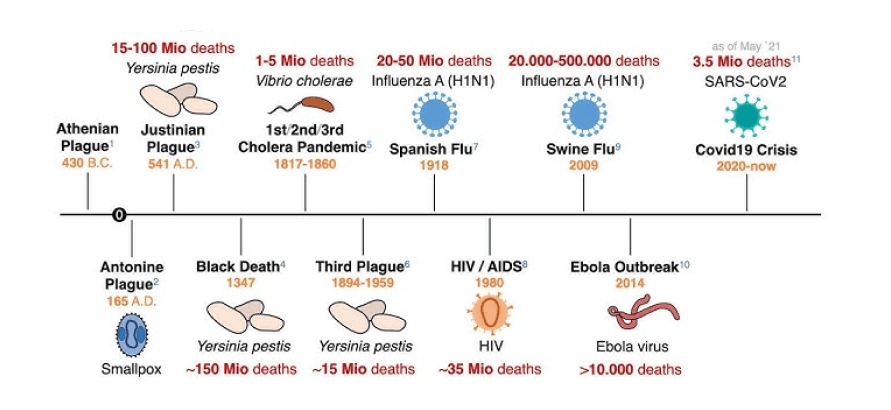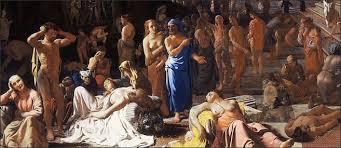Pandemics That Changed History: Timeline
Curated from: history.com
Ideas, facts & insights covering these topics:
18 ideas
·35.9K reads
160
4
Explore the World's Best Ideas
Join today and uncover 100+ curated journeys from 50+ topics. Unlock access to our mobile app with extensive features.
Spreading of diseases
Transmissible diseases existed during humankind’s hunter-gatherer days, but the shift to agrarian life 10,000 years ago created communities that made epidemics more possible.
We started building cities and forging trade routes to connect with other cities, declaring wars with them; all these made more likely the existence of pandemics.
407
3.51K reads
430 B.C.: Plague of Athens
The earliest recorded pandemic happened during the Peloponnesian War. It passed through Libya, Ethiopia, and Egypt, and it reached Athens as the Spartans laid siege.
Two-thirds of the population died.
The disease, suspected to have been typhoid fever, weakened the Athenians significantly and played a big role in their defeat by the Spartans.
417
3.18K reads
165 A.D.: The Antonine Plague
It may have been an early appearance of smallpox that began with the Huns.
The Huns then infected the Germans, who passed it to the Romans and then returning troops spread it throughout the Roman empire. This plague continued until about 180 A.D., claiming Emperor Marcus Aurelius as one of its victims.
396
2.78K reads
250 A.D.: Cyprian Plague
It is named after the first known victim, the Christian bishop of Carthage.
Possibly starting in Ethiopia, it passed through Northern Africa, into Rome, then onto Egypt and northward. City dwellers fled to the country to escape infection but instead spread the disease further.
Symptoms: diarrhea, vomiting, throat ulcers, fever and gangrenous hands and feet.
386
2.41K reads
541 A.D.: The Justinian Plague
It first appeared in Egypt, then spread to Palestine and the Byzantine Empire, and then throughout the Mediterranean.
The plague changed the course of the empire, forcefully changing Emperor Justinian's plans to bring the Roman Empire back together causing a massive economic struggle and creating an apocalyptic atmosphere that encouraged the rapid spread of Christianity.
Recurrences over the next two centuries eventually killed about 50 million people, 26 percent of the world population.
398
2.05K reads
11th Century: Leprosy
Though it had been around for ages, leprosy grew into a pandemic in Europe in the Middle Ages.
A slow-developing bacterial disease that causes sores and deformities, leprosy was believed to be a punishment from God that ran in families. This belief led to moral judgments and ostracization of victims. Now known as Hansen’s disease, it still afflicts tens of thousands of people a year and can be fatal if not treated with antibiotics.
392
1.92K reads
1350: The Black Death
Responsible for the death of one-third of the world population, this second large outbreak of the bubonic plague possibly started in Asia and moved west in caravans.
Entering through Sicily in 1347 A.D. when plague sufferers arrived in the port of Messina, it spread throughout Europe rapidly. Dead bodies became so prevalent that many remained rotting on the ground and created a constant stench in cities.
392
2.08K reads
1492: The Columbian Exchange
Following the arrival of the Spanish in the Caribbean, diseases such as smallpox, measles and bubonic plague were passed along to the native populations by the Europeans. With no previous exposure, these diseases devastated indigenous people, with as many as 90 percent dying throughout the north and south continents.
385
1.87K reads
1665: The Great Plague of London
The bubonic plague led to the deaths of 20 percent of London’s population. As human death tolls mounted and mass graves appeared, hundreds of thousands of cats and dogs were slaughtered as the possible cause and the disease spread through ports along the Thames.
385
1.85K reads
1817: First Cholera Pandemic
This wave of the small intestine infection originated in Russia, where one million people died. Spreading through feces-infected water and food, the bacterium was passed along to British soldiers who brought it to India where millions more died. The reach of the British Empire and its navy spread cholera to Spain, Africa, Indonesia, China, Japan, Italy, Germany and America, where it killed 150,000 people. A vaccine was created in 1885, but pandemics continued.
389
1.72K reads
1855: The Third Plague Pandemic
Starting in China and moving to India and Hong Kong, the bubonic plague claimed 15 million victims. Initially spread by fleas during a mining boom in Yunnan, the plague is considered a factor in the Parthay rebellion and the Taiping rebellion. India faced the most substantial casualties, and the epidemic was used as an excuse for repressive policies that sparked some revolt against the British. The pandemic was considered active until 1960 when cases dropped below a couple hundred.
388
1.66K reads
1875: Fiji Measles Pandemic
After Fiji ceded to the British Empire, a royal party visited Australia as a gift from Queen Victoria. Arriving during a measles outbreak, the royal party brought the disease back to their island, and it was spread further by the tribal heads and police who met with them upon their return.
Spreading quickly, the island was littered with corpses that were scavenged by wild animals, and entire villages died and were burned down, sometimes with the sick trapped inside the fires. One-third of Fiji’s population, a total of 40,000 people, died.
384
1.45K reads
1889: Russian Flu
The first significant flu pandemic started in Siberia and Kazakhstan, traveled to Moscow, and made its way into Finland and then Poland, where it moved into the rest of Europe. By the following year, it had crossed the ocean into North America and Africa. By the end of 1890, 360,000 had died.
384
1.55K reads
1918: Spanish Flu
The avian-borne flu that resulted in 50 million deaths worldwide, the Spanish flu is theorized to have originated in China and been spread by Chinese laborers being transported by rail across Canada on their way to Europe. In North America, the flu first appeared in Kansas in early 1918 and was visible in Europe by spring. Wire service reports of a flu outbreak in Madrid in the spring of 1918 led to the pandemic being called the “Spanish flu.”
By October, hundreds of thousands of Americans died and body storage scarcity hit crisis level. The flu threat disappeared in the summer of 1919.
388
1.52K reads
1957: Asian flu
Starting in Hong Kong and spreading throughout China and then into the United States, the Asian flu became widespread in England where, over six months, 14,000 people died. A second wave followed in early 1958, causing an estimated total of about 1.1 million deaths globally, with 116,000 deaths in the United States alone. A vaccine was developed, effectively containing the pandemic.
380
1.4K reads
1981: HIV/AIDS
AIDS was first observed in American gay communities but is believed to have developed from a chimpanzee virus from West Africa in the 1920s. It spreads through certain body fluids, moved to Haiti in the 1960s, and then New York and San Francisco in the 1970s.
Identified in 1981, AIDS destroys a person’s immune system, resulting in eventual death by diseases that the body would usually fight off. Those infected encounter fever, headache, and enlarged lymph nodes upon infection. When symptoms subside, carriers become infectious through blood and genital fluid, and the disease destroys t-cells.
387
1.53K reads
The 2003 Crisis
First identified in 2003 after several months of cases, Severe Acute Respiratory Syndrome infected infecting 8,096 people, with 774 deaths (from 26 countries)
It is characterized by respiratory problems, dry cough, fever and head and body aches and is spread through respiratory droplets from coughs and sneezes.
Quarantine efforts proved effective and by July, the virus was contained and hasn’t reappeared since.
379
1.61K reads
The 2019 Pandemic
On March 11, 2020, the World Health Organization announced that a new virus was officially a pandemic after barreling through 114 countries in three months and infecting over 118,000 people. And the spread wasn’t anywhere near finished.
The new virus spreads through droplets from sneezes.
The very first case in China appeared on November 17, 2019. There is still no vaccine available.
390
1.79K reads
IDEAS CURATED BY
Lauren W.'s ideas are part of this journey:
Learn more about health with this collection
How to use storytelling to influence and persuade
How to create a compelling narrative
How to structure your story for maximum impact
Related collections
Similar ideas
10 ideas
The 10 deadliest epidemics throughout history
health24.com
4 ideas
When Does an Epidemic Become a Pandemic?
verywellhealth.com
2 ideas
A visual history of pandemics
weforum.org
Read & Learn
20x Faster
without
deepstash
with
deepstash
with
deepstash
Personalized microlearning
—
100+ Learning Journeys
—
Access to 200,000+ ideas
—
Access to the mobile app
—
Unlimited idea saving
—
—
Unlimited history
—
—
Unlimited listening to ideas
—
—
Downloading & offline access
—
—
Supercharge your mind with one idea per day
Enter your email and spend 1 minute every day to learn something new.
I agree to receive email updates

















